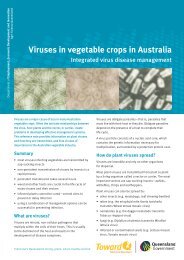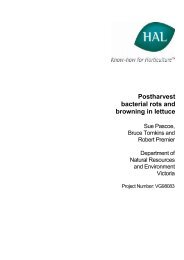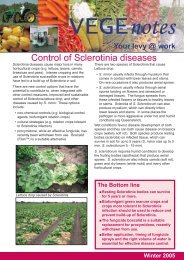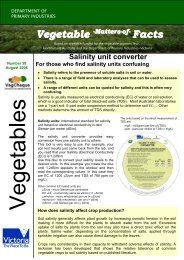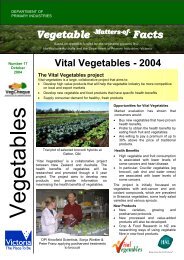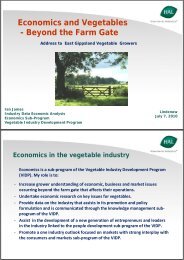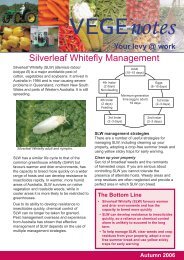Developing strategies to stimulate local consumption, export and ...
Developing strategies to stimulate local consumption, export and ...
Developing strategies to stimulate local consumption, export and ...
You also want an ePaper? Increase the reach of your titles
YUMPU automatically turns print PDFs into web optimized ePapers that Google loves.
Artichoke is a cross pollinated plant that can be propagated vegetatively as a perennial crop(using stumps <strong>and</strong> offshoots) or as an annual crop (using seeds). However, in some overseascountries (eg. Italy, France <strong>and</strong> Egypt) tissue culture is fast becoming an acceptablealternative <strong>to</strong> the traditional propagation techniques especially for the production of virus freematerial. Regardless of the propagation technique used, it takes between 5 <strong>to</strong> 7 months for aplant <strong>to</strong> produce heads ready for the first cut. Some overseas countries rely on foliarapplications of growth hormone sprays (eg. gibberellic acids) <strong>to</strong> increase earliness <strong>and</strong> theuniformity of bud development. The plant grows well in a range of soil conditions providingthey are fertile <strong>and</strong> well drained <strong>and</strong> prefers coastal areas with a mild frost-free climate withtemperatures between 15 <strong>to</strong> 20°C during bud formation in spring. Spacing between rows <strong>and</strong>plants will determine the size of the heads on the plant <strong>and</strong> the final number of plants in afield. Ryder et al. (1983) reviewed estimates for plant spacings which optimise <strong>to</strong>talyield/unit area for a number of artichoke producing countries. These estimates variedbetween countries <strong>and</strong> ranged from 0.18m 2 /plant in Egypt <strong>to</strong> 0.9m 2 /plant in USA (California).However, the authors maintained that increasing density generally decreased the yield/plant.Normally density would range between 3000 <strong>to</strong> 6000 plants/ha.There are a number of world wide artichoke cultivars with considerable morphologicalvariation such as size, bud shape, colour <strong>and</strong> spininess of the bracts. Many cultivars aresynonym, with some in Italy having up <strong>to</strong> fifteen different names given after the areas wherethey are grown (Prof. V. Bianco, personal communication). Major research centres forbreeding <strong>and</strong> cultivar selection exist in Italy, Spain <strong>and</strong> France. A comprehensive collectionof over 130 cultivars collected world wide is kept at the Gennplasm Institute, Bari Universityin Italy. Di Venere et al. (2000) found remarkable differences in the biochemical constituentsof 35 artichoke cultivars. According <strong>to</strong> the researchers such useful information could helpdetermining the suitability of various cultivars <strong>to</strong> specific uses such as fresh, frozen, brined orpreserved in oil.3.3 World productionIn 1999 the world's production of artichoke was about 1.2 million <strong>to</strong>nnes from an area of119,000 hectares (Anon. 1999a). Nearly 85% of the world's artichokes are grown incountries bordering the Mediterranean basin (Bianco, 2000). Italy <strong>and</strong> Spain dominate theworld production with other countries showing great interest in the crop. In the Northernhemisphere, Egypt is exp<strong>and</strong>ing its production ranking fifth in the world <strong>and</strong> becoming anaggressive <strong>export</strong>er <strong>to</strong> markets in Europe <strong>and</strong> Northern America. The USA has also beenexp<strong>and</strong>ing its production steadily with most of it located in the central <strong>and</strong> southern coastalareas of California. Argentina <strong>and</strong> Chile are two Southern hemisphere countries showinginterest in exp<strong>and</strong>ing their artichoke production. Table 1 lists the world <strong>to</strong>p producingcountries in 1999 <strong>and</strong> periods when the crop is available on their <strong>local</strong> markets. However, thedates listed are only a guide <strong>and</strong>jcould differ by a few weeks within the same countrydepending on the region where artichoke is grown <strong>and</strong>/or prevailing weather conditionsduring the growing season.



